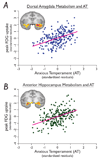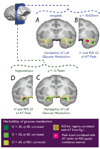Amygdalar and hippocampal substrates of anxious temperament differ in their heritability
- PMID: 20703306
- PMCID: PMC2998538
- DOI: 10.1038/nature09282
Amygdalar and hippocampal substrates of anxious temperament differ in their heritability
Abstract
Anxious temperament (AT) in human and non-human primates is a trait-like phenotype evident early in life that is characterized by increased behavioural and physiological reactivity to mildly threatening stimuli. Studies in children demonstrate that AT is an important risk factor for the later development of anxiety disorders, depression and comorbid substance abuse. Despite its importance as an early predictor of psychopathology, little is known about the factors that predispose vulnerable children to develop AT and the brain systems that underlie its expression. To characterize the neural circuitry associated with AT and the extent to which the function of this circuit is heritable, we studied a large sample of rhesus monkeys phenotyped for AT. Using 238 young monkeys from a multigenerational single-family pedigree, we simultaneously assessed brain metabolic activity and AT while monkeys were exposed to the relevant ethological condition that elicits the phenotype. High-resolution (18)F-labelled deoxyglucose positron-emission tomography (FDG-PET) was selected as the imaging modality because it provides semi-quantitative indices of absolute glucose metabolic rate, allows for simultaneous measurement of behaviour and brain activity, and has a time course suited for assessing temperament-associated sustained brain responses. Here we demonstrate that the central nucleus region of the amygdala and the anterior hippocampus are key components of the neural circuit predictive of AT. We also show significant heritability of the AT phenotype by using quantitative genetic analysis. Additionally, using voxelwise analyses, we reveal significant heritability of metabolic activity in AT-associated hippocampal regions. However, activity in the amygdala region predictive of AT is not significantly heritable. Furthermore, the heritabilities of the hippocampal and amygdala regions significantly differ from each other. Even though these structures are closely linked, the results suggest differential influences of genes and environment on how these brain regions mediate AT and the ongoing risk of developing anxiety and depression.
Figures



Comment in
-
Behavioural neuroscience: Genes and the anxious brain.Nature. 2010 Aug 12;466(7308):827-8. doi: 10.1038/466827a. Nature. 2010. PMID: 20703297 No abstract available.
References
-
- Schwartz CE, et al. Inhibited and uninhibited infants "grown up": adult amygdalar response to novelty. Science. 2003;300:1952–1953. - PubMed
-
- Kagan J, Reznick JS, Snidman N. Biological bases of childhood shyness. Science. 1988;240:167–171. - PubMed
-
- Fox NA, et al. Behavioral inhibition: linking biology and behavior within a developmental framework. Annu Rev Psychol. 2005;56:235–262. - PubMed
-
- Biederman J, et al. Further evidence of association between behavioral inhibition and social anxiety in children. Am J Psychiatry. 2001;158:1673–1679. - PubMed
Publication types
MeSH terms
Substances
Grants and funding
LinkOut - more resources
Full Text Sources
Other Literature Sources
Medical

